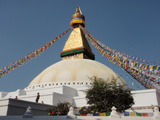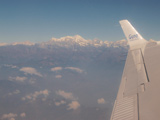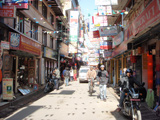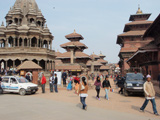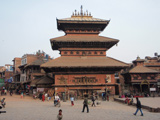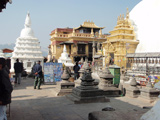 |
Nepal (official name Nepāl Adhirājya, Kingdom of Nepal), is a state of centre-south Asia; without coastal outlet, it borders in the north with China and in the west, south and east with India. It has a surface of 147.181 SqKm; the capital city is Kathmandu.
Kathmandu (or Katmandu), capital of Nepal is the administrative, economic and cultural centre of the country and is located on a rich valley in the south slopes of Himalaya, on a height of 1.372 m., between the rivers Bagmati and Visnumati. These two rivers basically define the urban area in the strict sense of the word, the second laps it in the north, whereas the first, sacred river to the hindu, bounds it in the east and south, dividing it from the near town of Patan (entrance ticket for turists: 200 NPR), ancient capital of the kingdom. The urban area is characterized by a morphology that presents many bumps corresponding to the several hills that separate the valleys to the different rivers that flow down into the Bagmati before this one gets inside the famous Gorge of Chobar. The town, not far from some of the highest mountains of Himalaya range, is the departure base for trekking and climbing expeditions, as well as the economic, religious and cultural heart of the country. The local industry is poorly developed, whereas handicraft (ivory, textiles, copper items) is very active. The town is connected to Lhasa, in Tibet, by a road. Besides the several buddhist and hindu sanctuaries in town and in the nearby, particularly interesting under the historical-artistic point of view is the Royal Palace, lavishly decorated and containing a buddhist temple of 1549. In the immediate vicinity of the town rises the spectacular Stupa of Bodnah (entrance ticket for tourists: 100 NPR) of hemispheric form, pilgrimage destination of tibetan buddhists. It is located 500 m. from Hyatt hotel. All around the stupa are located souvenir shops and small reastaurants. In Kathmandu are located the University Tribhuvan, of 1959, and the National Museum.
The town was founded in 723 and was dominated for centuries by the people of newar. In 1768 it was conquered by the gurkha, that did their capital. From 1846 to 1950 it was governed by the powerful Rana dynasty, that dominated the entire nation. It is the biggest town of the country, with a population of 950 thousand inhabitants in the urban area (data 2007). In the all metropolitan area, which includes also the towns of Patan, Badgaon, Thimi, etc., it exceeds the 2 millions inhabitants (data 2007).
It is very interesting to visit the medieval town of Bhaktapur (Bhatghaon, 14 Km. from the centre, entrance ticket for the tourists: 500 NPR), considered by the UNESCO as heritage of mankind, the most beautiful town in Nepal, with magnificent palaces and nice pagodas, thriving handicraft in wood carving and earthenware manufacture. The urban centre of Kathmandu presents a historical complex mostly dating XVII century (late period Malla) that develops around the very famous Durbar Square, inserted by UNESCO in the list of Geritage of Human Mankind, (entrance ticket: 300 NPR) rich of hindu temples where take place markets, and several stalls sell objects of the local handmade articles. Many other temples are isolated the ones from the others near many crossroads (nepalese: chowk), consequently in the town are concentrated, as in the all valley, hundreds of hindu temples; among them the most famous one is the one of Pashupatinah (entrance ticket for the turists: 500 NPR, called Benares of Nepal) on the banks of the sacred river Bagmati, where in the area are lined up on the right hand side of the river many stony plinths used for the pyres to cremate the corpses.
There are also many buddhist places as the famous Swayambunath, (entrance ticket for the turists: 200 NPR), known also as the Temple of the monkeys, situated on the top of a hill on the west of the town; it can be reached by taxi but also by local bus which costs only 15 NPR, but it takes sometimes an hour because of the heavy traffic; and the temple of Bodnah on the oriental outskirts where live a consistent tibetan community escaped from the chinese persecutions. It is not a case that in these places there is the main concentration of religious buildings of the planet. Many of the buildings in the historical centre have been damaged in the past by the earthquakes and more recently by the pollution. In the same part of the town there is also a large grassy flat space partly equipped as park, with sport zones. This area is a urban whole which includes the Royal Palace and its parks, surrounded by high walls and railings. In the building growth, the town has absorbed villages and small urban conglomeration in the nearby, reaching and surpassing the banks of the above mentioned rivers combining with Patan in the south of Bagmati river and united to Kathmandu by a big bridge.
Just in the north of the historical centre and without a break, from the 80ies of the XX century developed the turistic quarter of Thamel, characterized by narrow streets crowded with pedal and motor vehicles, and pedestrians, where you find hundreds of small hotels, guest houses, restaurants, bazaar and shops attended by western turists that crowd this part of the town in order to visit not only the huge monumental heritage, but also to organize trips to other zones in Nepal for trekking, rafting on the rivers or mountain-climbing. The fabric of the city is therefore characterized by a considerable urban disorder, sign of a turbulent urban and demographic growth: it seems that the population in the metropolitan area rises with a rhythm of 150 thousand inhabitants a year. Enough to observe that for example in Kathmandu the streets, apart from some exceptions concerning the main roads, do not have a name, and because of that you find your way referring to the main chowks: Indra Chock, Asan Tole, Thaiti Tole, Chetrapati and many others are the urban point of reference for the multitude of shops, houses, hotels and restaurants that are located around, within a range of 100 or 200 m. Who wants to be sure to receive the mail must have a P.O. Box. Furthermore, the town does not have street lamps, there is no light during the night and at 10 p.m. all shops and restaurants close. Taxi increase their fare, after 9 p.m., they have the taximeter in the car but they never use it, and it is compulsory to bargain the price for the destination.
In the oriental zone of the town, beyond the Bagmati river, is located the airport of Tribhuvan that even if it is the only one international in Nepal (direct connections with India, Middle and Far East, but also with some towns in Europe), is charcaterized by a modest passenger traffic: less than 500 thousand passengers a year. The visa can be obtained directly in the airport paying a tax of 25 USD; to leave the country the tax of 16 USD is no more due. From the 60ies Kathmandu became a very popular destination for western turists, and changed into an obliged stop for the followers of the hippy culture. It is said that Kathmandu was founded by the king Guna Kamadeva in 723 a. Ch. It became the capital of the united Nepal after the capture of the town by king Prithvi Narayan Shah in 1768.
Apart from the visit to the different monuments in town and in the outskirts, it is also worth to make an hour flight to the mountainous range of Himalaya till Everest, 8.848 m., the highest mountain in the world. There are three air companies that daily organize this kind of excursion: Buddha Airlines, Guna Airlines and Yeti Airlines. The flight ticket costs 156 USD and can be booked in every agency. It is possible to bargain the price and have a little discount. I got the ticket for 137 USD. After landing at the airport you receive a certificate from the company which certifies you did one of the most extraordinary flights in the world. Hotels are mostly guest houses where you can rent a room for 20/25 USD breakfast included. I visited the Ti-se Guest house, in front of Hyatt Hotel, a little out of the town, new building, very well furnished, clean and essential where prices start from 12 USD for a single room and reach 45 USD for a suite with two rooms and a bathroom. Free wi-fi service. The web site is: www.tiseguesthouse.com
If on the contrary you want to spend a stay in the luxury, Hyatt Regency***** is one of the best hotels, far from the caos of the town, where a room costs an average of 135 USD + 24% of VAT and service charge, breakfast included. The site is: www.kathmandu.regency.hyatt.com
Currency in Nepal: Nepalese Rupee (NPR)
Foreign exchange on 06th of December, 2009:
1 € = 108 NPR - 1 USD = 73,40 NPR
Time zone difference with Italy: +4h 45' (solar time)

